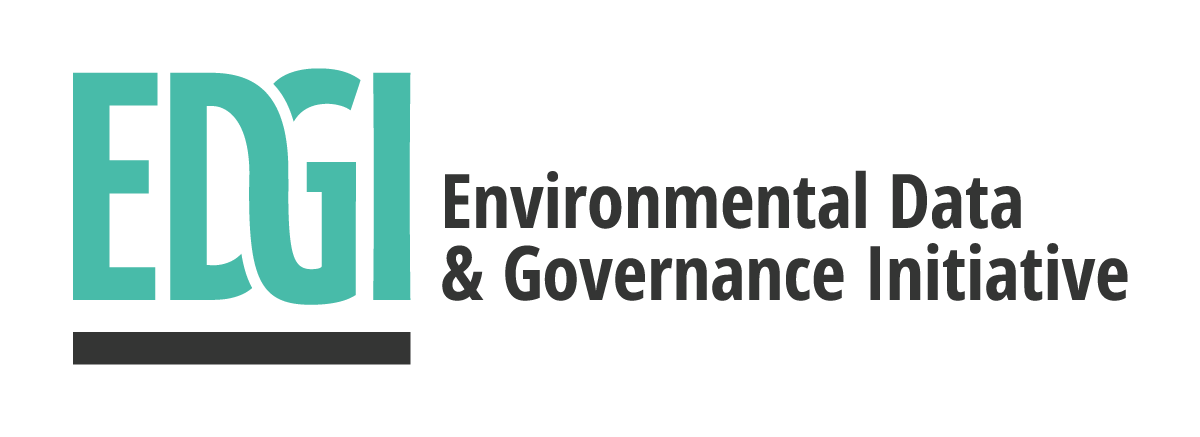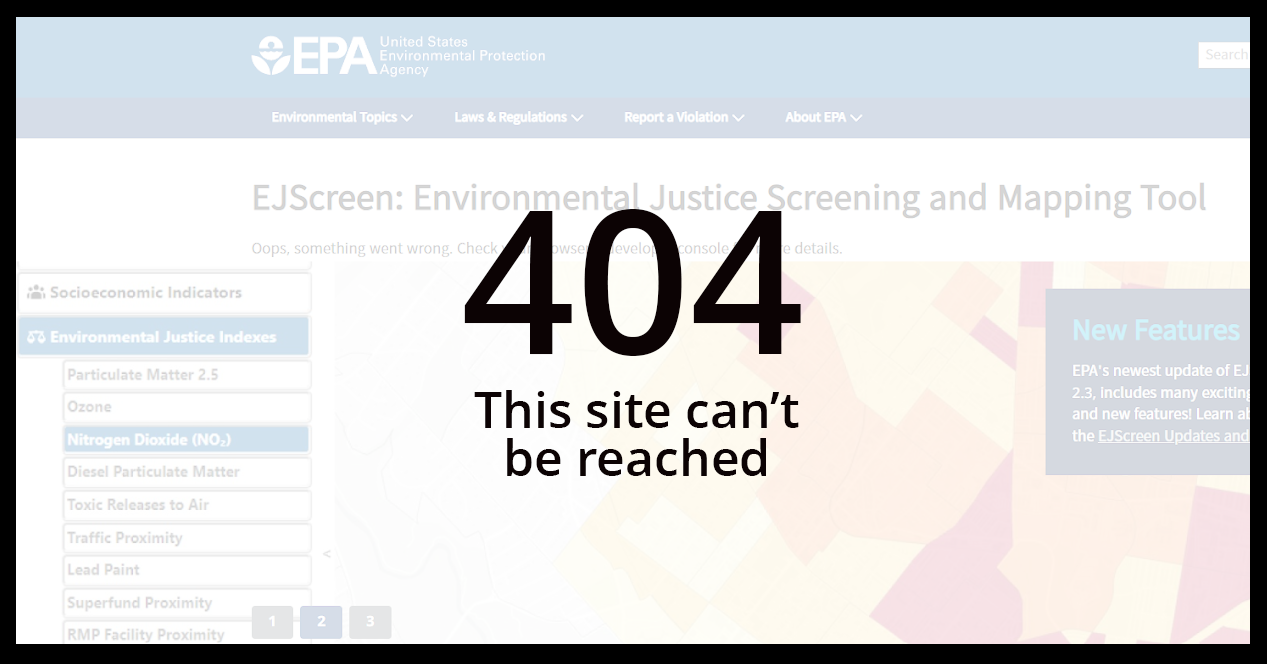Removed federal environmental justice mapping and screening tool, EJScreen.
Highlights from the Change Log: EPA Removes EJScreen from its Website
Welcome! This post is part of the EDGI Website Monitoring Team’s “Highlights from the Change Log” blog series. The purpose of this series is to highlight interesting changes we have observed in the language used on, or access to, federal websites. We want to share these changes to encourage public engagement with and discussion of their significance, as well as understanding of the ephemeral nature of website information. These website changes happened on February 5 and feature deletions of EPA pages about the environmental justice mapping and screening tool, EJScreen, as well as the tool itself.
What Happened?
On February 5th, EPA removed from its website the environmental justice mapping and screening tool, EJScreen, as well as several related web pages. These pages, which now cannot be accessed or simply say, “Sorry, but this web page does not exist,” include:
- The main landing page for EJScreen, including links to technical information, tutorials, and environmental justice efforts at EPA
- The page for using the EJScreen tool
- The page for downloading EJScreen data products for offline use
- The ArcGIS server that distributes the spatial data behind EJScreen
These efforts coincide with EPA’s removal of several web pages related to diversity, equity, and inclusion (DEI) this January. In addition, EPA’s environmental justice page has been significantly altered and no longer links to EJScreen. At the time of this writing, however, several other EPA pages about environmental justice are still available.
Public Environmental Data Partners (PEDP) released a reconstruction of Version 2.3 of EPA’s EJScreen. PEDP is committed to preserving and providing public access to federal environmental data. They are a volunteer coalition of several environmental, justice, and policy organizations, and others, including EDGI, who rely on federal datasets and tools to support critical research, advocacy, policy, and litigation work. Find out more about their work here.
Why We Think it’s Interesting:
EDGI previously noted how Donald Trump’s executive order on DEI initiatives and the Office of Personnel Management’s memo to agency leaders requiring them to shut down DEI offices precipitated changes to EPA web content related to DEI. In this case, the Trump administration’s decision to revoke Executive Order 12898, which was instrumental to the eventual development of the EJScreen tool, put an even larger target on longstanding environmental justice initiatives. In addition, on February 6 it was reported that the EPA had placed over 100 employees at the Office of Environmental Justice and External Civil Rights (OEJECR) on leave.
During the first Trump administration, EDGI documented the suppression of information on a variety of topics, including climate change and environmental impacts from burning fossil fuels. However, EDGI did not observe the outright removal of data and mapping tools such as EJScreen.
Members of the public and various institutions use and benefit from EJScreen. States like Maryland and Massachusetts have developed state-level environmental justice mapping tools like it. Furthermore, projects addressing the concerns of communities disparately impacted by pollution and other environmental harms in the U.S. frequently make use of the EJScreen tool. Educators have also used EJScreen to engage students with environmental and social topics through data. Before it was removed, the EJScreen Office Hours & Training page still listed upcoming EJScreen Office Hours meetings, including one scheduled for February 19, 2025. All of this activity indicates EJScreen is widely used and is popular with many members of the public.
EJScreen has been a flagship tool for beginning to examine cumulative impacts. It allowed the public to map “EJ Indexes,” which combined metrics for environmental burdens with demographic indexes derived from U.S. Census data on poverty and racial demographics. The removal of this tool will severely hinder most individuals from accessing EPA, U.S. Census, and other agency data that was made conveniently accessible through EJScreen. Moreover, the removal of EJScreen suppresses the way these indexes were used to measure injustice and other unequal environmental conditions. As such, the removal of this tool limits how members of the public can organize, analyze, and present information about environmental and social conditions within their communities.
More Details:
Pages that have been removed:
EJScreen: Environmental Justice Screening and Mapping Tool: January 23, 2025 vs. February 5, 2025
EJScreen Mapper: January 23, 2025
- As of February 6, 2025, this URL (https://ejscreen.epa.gov/mapper) is inaccessible and web browsers cannot resolve its domain. Therefore, we cannot provide a link to an archived snapshot of this webpage.
Download EJScreen Data: January 24, 2025 vs. February 5, 2025
Learn to Use EJScreen: January 23, 2025 vs. February 7, 2025
EJScreen Office Hours & Training: January 23, 2025 vs. February 5, 2025
EPA ArcGIS REST Services Directory EJScreen folder: January 22, 2025 vs. February 5, 2025
- The February 5, 2025 snapshot shows no outgoing links in this folder.
- As of February 6, 2025, this URL (https://ejscreen.epa.gov/arcgis/rest/services/ejscreen) is inaccessible and web browsers cannot resolve its domain.
Environmental Justice Screening and Mapping Tool: January 30, 2025 vs. February 6, 2025
- This webpage is from the coast.noaa.gov domain. It used to link to the EJScreen tool and included additional information about EJScreen. It now redirects to a 404 error page.
Many other pages about EJScreen have been removed from EPA’s site. In addition, some of the EJScreen tutorial videos that had been uploaded to Youtube have been made private, as of February 7. (January 21, 2025 vs. February 7, 2025)

